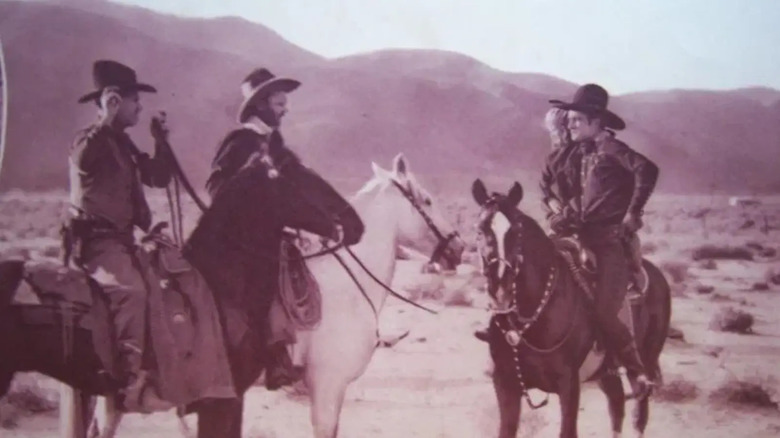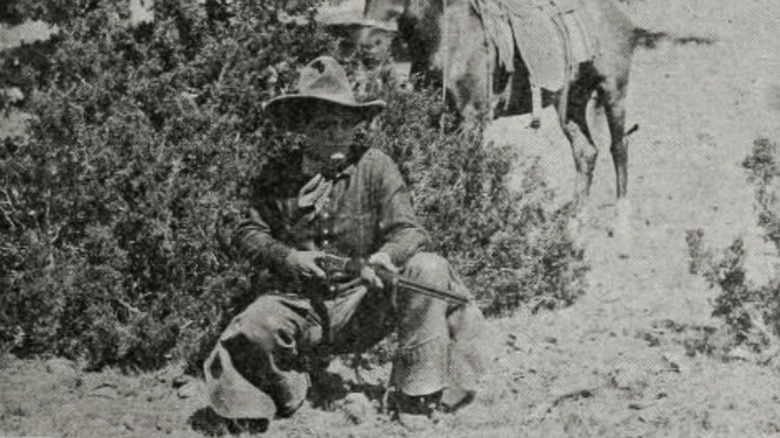Before John Ford And Sergio Leone, One Director Dominated The Western Genre
Content warning: this article contains a mention of suicide.
1910s and 1920s Hollywood was the Wild West — and not just because it was churning out so many Westerns. Damien Chazelle's "Babylon" isn't visually accurate, but it captures the spirit of the era. The first kinetograph camera had only been invented about 25 years earlier, and it proliferated quickly, giving birth to a new artistic medium and a new financial industry in swift order. Filmmakers in Los Angeles brought cameras out to the deserts of California, wrangled a few horses, hired actors from then-popular live Wild West shows, and almost deliberately created a genre. Westerns soon became one of the most cost-efficient and popular genres, and studios demanded that directors throw together as many as they could on as narrow a timetable as possible.
Hence, the filmographies of silent film stars and their directors were overwhelmingly plentiful when compared to filmmakers today. Indeed, many silent filmmakers were able to complete entire features in a matter of weeks, sometimes even days.
Case in point: Lynn Reynolds. Perhaps best known for his 1925 adaptation of Zane Grey's "Riders of the Purple Sage," Reynolds was one of the uncontested masters of the Western in the silent era. From 1915 to 1927, Reynolds directed over 80 shorts and features and wrote an additional 58, many of them in the Western genre. Reynolds began his career in his native Iowa, working as a reporter for a local newspaper. As a young man, he moved to Los Angeles and began directing films for Universal. His first short was the 1915 movie "Both Sides of Life," a melodramatic romance about a theology student and the woman he loves. Then, in 1915 alone, Reynolds directed nine additional short films. He truly hit the ground running.
Reynolds, however, was prolific yet unhappy. The story of his death is just as notorious as his massive output.
The sad story of Lynn Reynolds
Lynn Reynolds' first feature-length film (that is: over 40 minutes) was 1916's "It Happened in Honolulu," another romantic melodrama, this time between a wealthy young woman and a carefree fishmonger. Reynolds made a lot of tragedies and romances about love and friendship. They were mostly overwrought character pieces with broken hearts, stilted longing, and "inappropriate" mixed-class relationships. These types of melodrama were just as common as Westerns in the 1910s, although they still persist to this day. Reynolds' first feature-length Western was probably 1917's "Broadway Arizona," a film about a cattle rancher finding love in the big city.
In 1918, he made "Western Blood" with the prolific cowboy star Tom Mix, and he was off to the races, as it were. The bulk of Reynold's output from then on was in the Western genre. Reynolds went on to work with Mix a few more times and kept his output high after that. He ultimately made five or six films a year every year until his death in 1927 at the age of 37.
The story of Reynolds' death is a tragic one. It seems that he and his wife Kathleen O'Connor had a tempestuous relationship, and the pair often fought. Some reports have alleged that Reynolds was abusive to O'Connor. Then, in 1927, the pair had arranged a dinner party with another couple after a three-week stint of Reynolds being unexpectedly snowbound in the Sierra Nevadas. Having company over didn't stop them from heatedly arguing, though. Reports said that Reynolds and O'Connor accused one another of infidelity before Reynolds stormed out of the room to fetch a gun. He then proceeded to die by suicide in front of his wife.
Reynolds' last film was "Hey! Hey! Cowboy," a 1927 Western that was completed by director Edward Laemmle (the nephew of Universal honcho and war film enthusiast Carl Laemmle).

